Financial Reporting Report: Fundamental Characteristics and Decisions
VerifiedAdded on 2020/07/22
|6
|1349
|56
Report
AI Summary
This report provides a comprehensive overview of financial reporting, emphasizing its significance for organizations and stakeholders. It delves into the fundamental characteristics of financial reporting, as defined by IFRS, including relevance, faithful representation, materiality, comparability, verifiability, timeliness, and understandability. The report also explores the role of financial reporting in short-term decision-making, analyzing factors such as contribution per unit, break-even points, fixed costs, and variable costs. The conclusion highlights the importance of financial reporting for smooth operations and its role in attracting investors. The report references key academic sources, providing a strong foundation for the presented concepts.
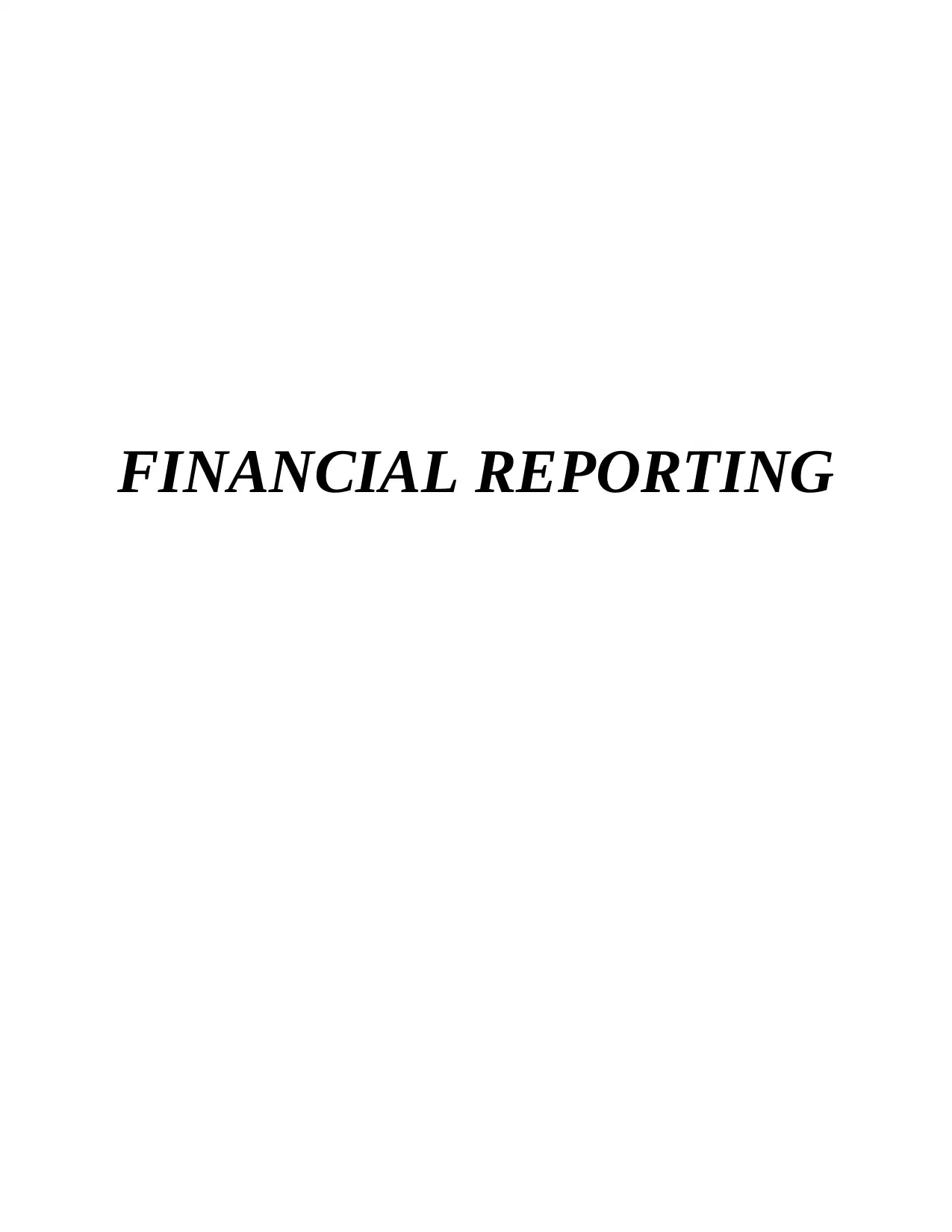
FINANCIAL REPORTING
Paraphrase This Document
Need a fresh take? Get an instant paraphrase of this document with our AI Paraphraser
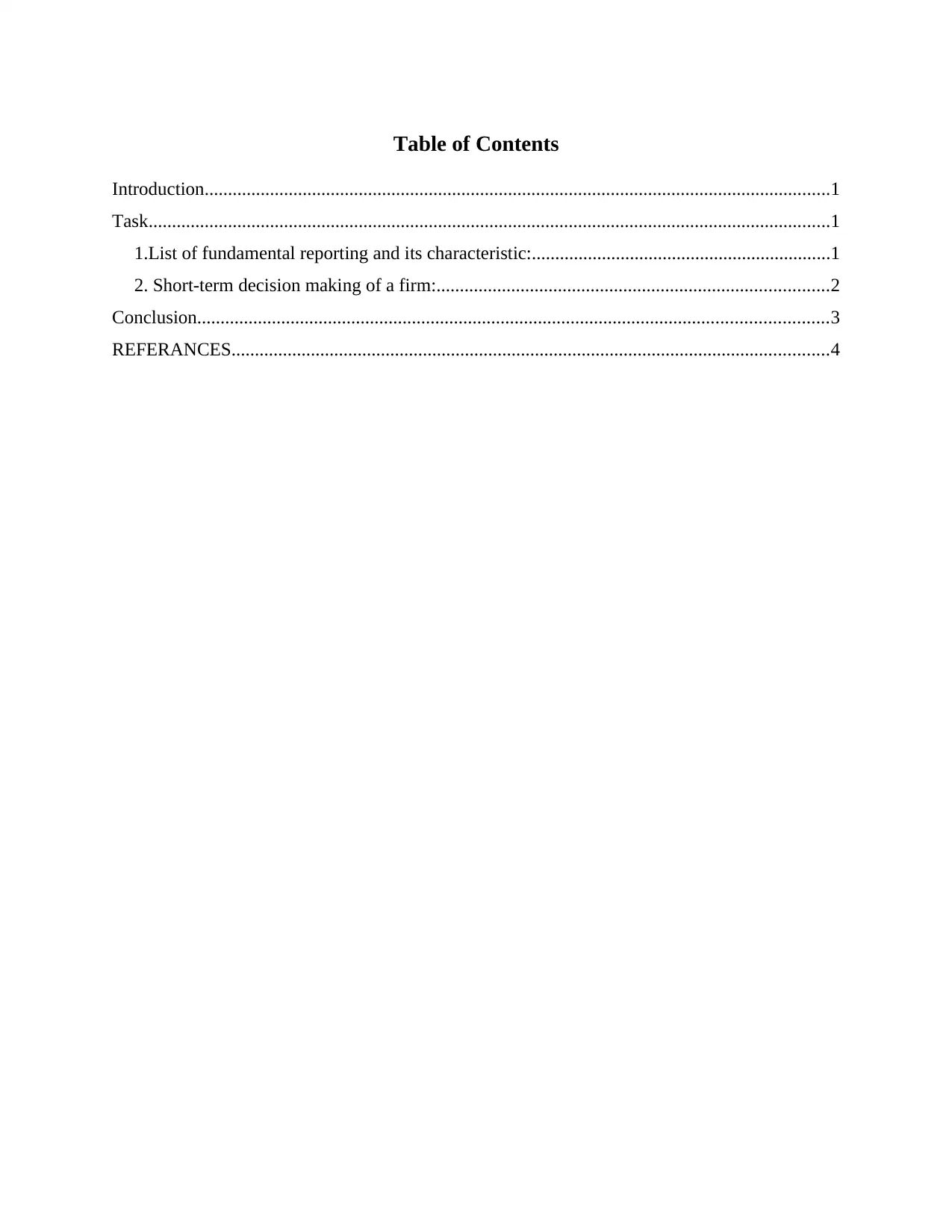
Table of Contents
Introduction......................................................................................................................................1
Task..................................................................................................................................................1
1.List of fundamental reporting and its characteristic:................................................................1
2. Short-term decision making of a firm:....................................................................................2
Conclusion.......................................................................................................................................3
REFERANCES................................................................................................................................4
Introduction......................................................................................................................................1
Task..................................................................................................................................................1
1.List of fundamental reporting and its characteristic:................................................................1
2. Short-term decision making of a firm:....................................................................................2
Conclusion.......................................................................................................................................3
REFERANCES................................................................................................................................4
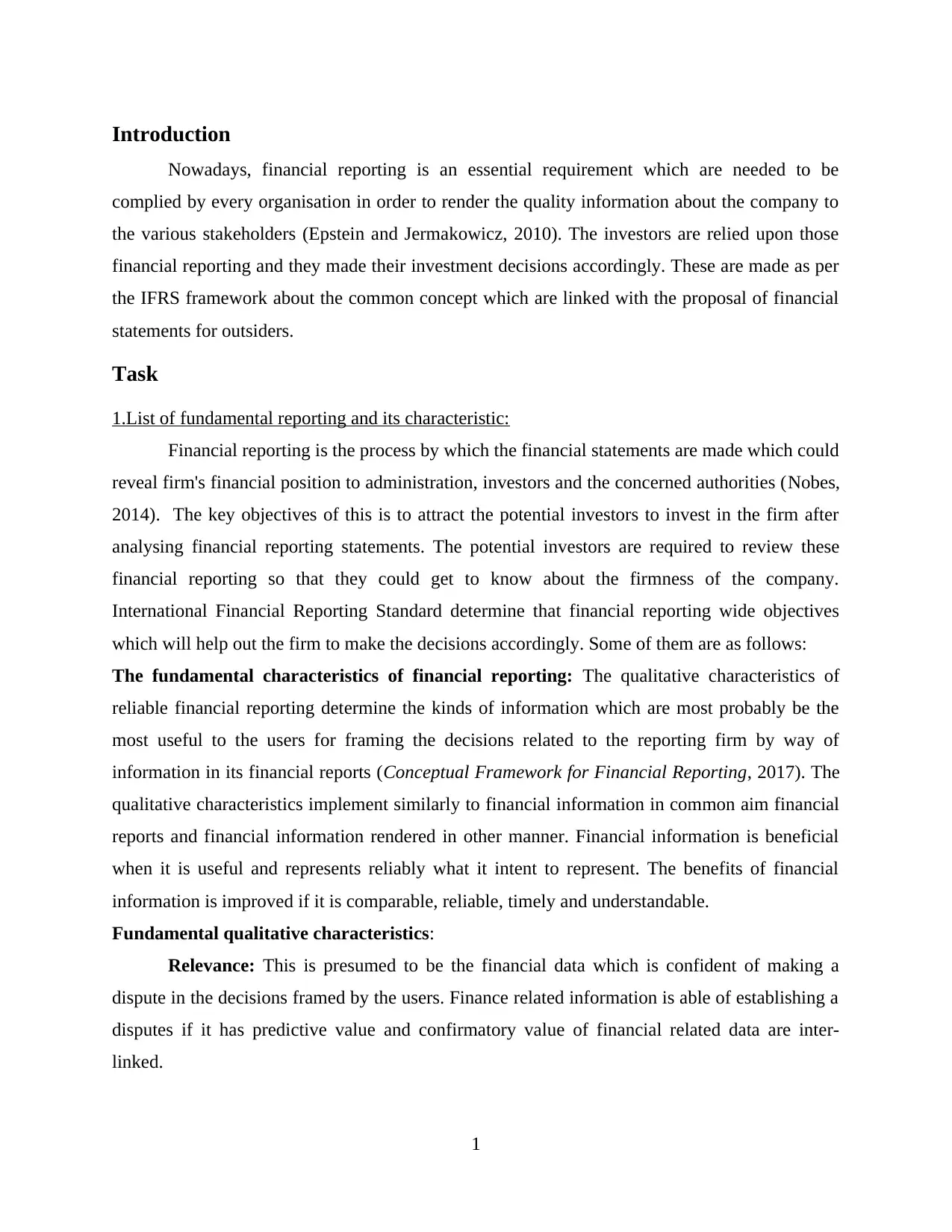
Introduction
Nowadays, financial reporting is an essential requirement which are needed to be
complied by every organisation in order to render the quality information about the company to
the various stakeholders (Epstein and Jermakowicz, 2010). The investors are relied upon those
financial reporting and they made their investment decisions accordingly. These are made as per
the IFRS framework about the common concept which are linked with the proposal of financial
statements for outsiders.
Task
1.List of fundamental reporting and its characteristic:
Financial reporting is the process by which the financial statements are made which could
reveal firm's financial position to administration, investors and the concerned authorities (Nobes,
2014). The key objectives of this is to attract the potential investors to invest in the firm after
analysing financial reporting statements. The potential investors are required to review these
financial reporting so that they could get to know about the firmness of the company.
International Financial Reporting Standard determine that financial reporting wide objectives
which will help out the firm to make the decisions accordingly. Some of them are as follows:
The fundamental characteristics of financial reporting: The qualitative characteristics of
reliable financial reporting determine the kinds of information which are most probably be the
most useful to the users for framing the decisions related to the reporting firm by way of
information in its financial reports (Conceptual Framework for Financial Reporting, 2017). The
qualitative characteristics implement similarly to financial information in common aim financial
reports and financial information rendered in other manner. Financial information is beneficial
when it is useful and represents reliably what it intent to represent. The benefits of financial
information is improved if it is comparable, reliable, timely and understandable.
Fundamental qualitative characteristics:
Relevance: This is presumed to be the financial data which is confident of making a
dispute in the decisions framed by the users. Finance related information is able of establishing a
disputes if it has predictive value and confirmatory value of financial related data are inter-
linked.
1
Nowadays, financial reporting is an essential requirement which are needed to be
complied by every organisation in order to render the quality information about the company to
the various stakeholders (Epstein and Jermakowicz, 2010). The investors are relied upon those
financial reporting and they made their investment decisions accordingly. These are made as per
the IFRS framework about the common concept which are linked with the proposal of financial
statements for outsiders.
Task
1.List of fundamental reporting and its characteristic:
Financial reporting is the process by which the financial statements are made which could
reveal firm's financial position to administration, investors and the concerned authorities (Nobes,
2014). The key objectives of this is to attract the potential investors to invest in the firm after
analysing financial reporting statements. The potential investors are required to review these
financial reporting so that they could get to know about the firmness of the company.
International Financial Reporting Standard determine that financial reporting wide objectives
which will help out the firm to make the decisions accordingly. Some of them are as follows:
The fundamental characteristics of financial reporting: The qualitative characteristics of
reliable financial reporting determine the kinds of information which are most probably be the
most useful to the users for framing the decisions related to the reporting firm by way of
information in its financial reports (Conceptual Framework for Financial Reporting, 2017). The
qualitative characteristics implement similarly to financial information in common aim financial
reports and financial information rendered in other manner. Financial information is beneficial
when it is useful and represents reliably what it intent to represent. The benefits of financial
information is improved if it is comparable, reliable, timely and understandable.
Fundamental qualitative characteristics:
Relevance: This is presumed to be the financial data which is confident of making a
dispute in the decisions framed by the users. Finance related information is able of establishing a
disputes if it has predictive value and confirmatory value of financial related data are inter-
linked.
1
⊘ This is a preview!⊘
Do you want full access?
Subscribe today to unlock all pages.

Trusted by 1+ million students worldwide
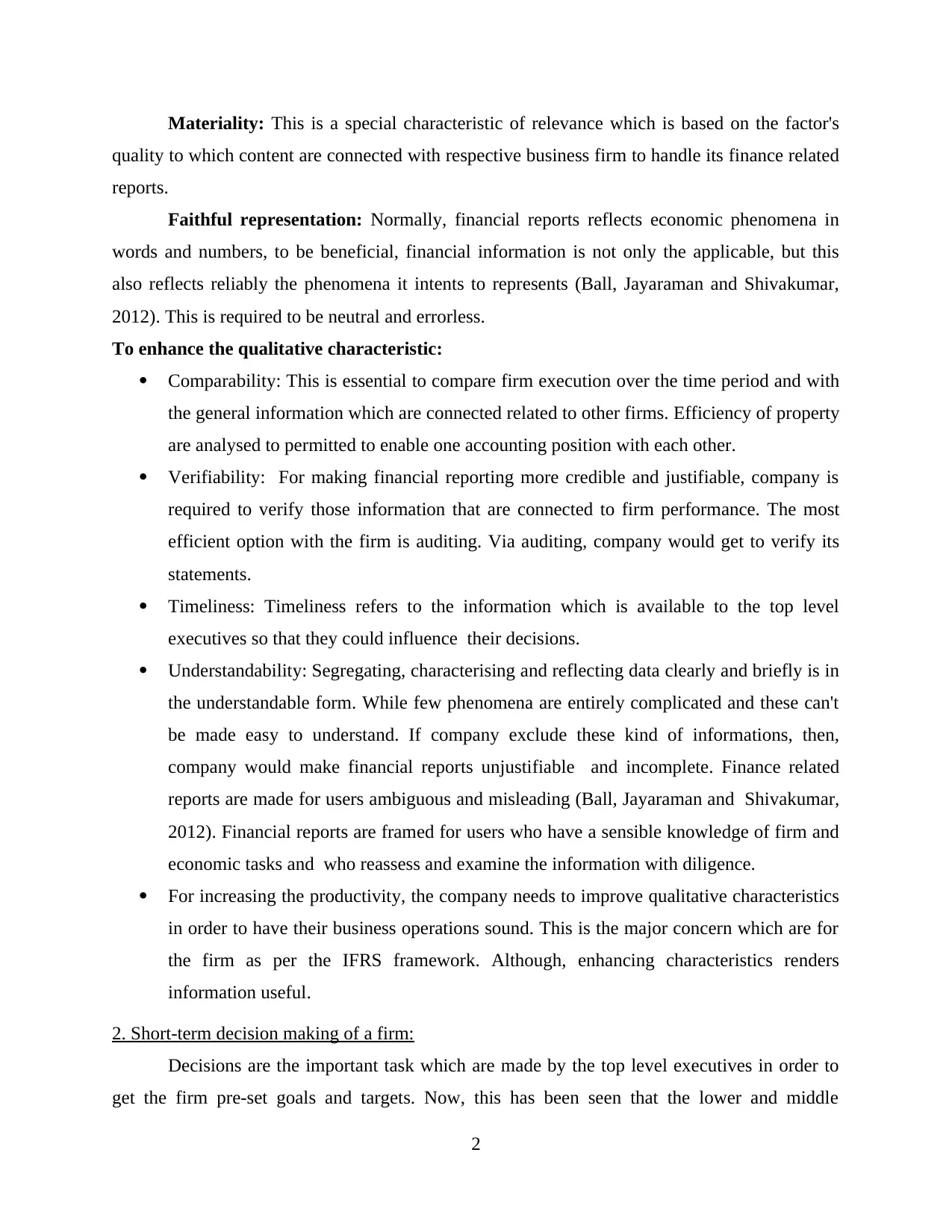
Materiality: This is a special characteristic of relevance which is based on the factor's
quality to which content are connected with respective business firm to handle its finance related
reports.
Faithful representation: Normally, financial reports reflects economic phenomena in
words and numbers, to be beneficial, financial information is not only the applicable, but this
also reflects reliably the phenomena it intents to represents (Ball, Jayaraman and Shivakumar,
2012). This is required to be neutral and errorless.
To enhance the qualitative characteristic:
Comparability: This is essential to compare firm execution over the time period and with
the general information which are connected related to other firms. Efficiency of property
are analysed to permitted to enable one accounting position with each other.
Verifiability: For making financial reporting more credible and justifiable, company is
required to verify those information that are connected to firm performance. The most
efficient option with the firm is auditing. Via auditing, company would get to verify its
statements.
Timeliness: Timeliness refers to the information which is available to the top level
executives so that they could influence their decisions.
Understandability: Segregating, characterising and reflecting data clearly and briefly is in
the understandable form. While few phenomena are entirely complicated and these can't
be made easy to understand. If company exclude these kind of informations, then,
company would make financial reports unjustifiable and incomplete. Finance related
reports are made for users ambiguous and misleading (Ball, Jayaraman and Shivakumar,
2012). Financial reports are framed for users who have a sensible knowledge of firm and
economic tasks and who reassess and examine the information with diligence.
For increasing the productivity, the company needs to improve qualitative characteristics
in order to have their business operations sound. This is the major concern which are for
the firm as per the IFRS framework. Although, enhancing characteristics renders
information useful.
2. Short-term decision making of a firm:
Decisions are the important task which are made by the top level executives in order to
get the firm pre-set goals and targets. Now, this has been seen that the lower and middle
2
quality to which content are connected with respective business firm to handle its finance related
reports.
Faithful representation: Normally, financial reports reflects economic phenomena in
words and numbers, to be beneficial, financial information is not only the applicable, but this
also reflects reliably the phenomena it intents to represents (Ball, Jayaraman and Shivakumar,
2012). This is required to be neutral and errorless.
To enhance the qualitative characteristic:
Comparability: This is essential to compare firm execution over the time period and with
the general information which are connected related to other firms. Efficiency of property
are analysed to permitted to enable one accounting position with each other.
Verifiability: For making financial reporting more credible and justifiable, company is
required to verify those information that are connected to firm performance. The most
efficient option with the firm is auditing. Via auditing, company would get to verify its
statements.
Timeliness: Timeliness refers to the information which is available to the top level
executives so that they could influence their decisions.
Understandability: Segregating, characterising and reflecting data clearly and briefly is in
the understandable form. While few phenomena are entirely complicated and these can't
be made easy to understand. If company exclude these kind of informations, then,
company would make financial reports unjustifiable and incomplete. Finance related
reports are made for users ambiguous and misleading (Ball, Jayaraman and Shivakumar,
2012). Financial reports are framed for users who have a sensible knowledge of firm and
economic tasks and who reassess and examine the information with diligence.
For increasing the productivity, the company needs to improve qualitative characteristics
in order to have their business operations sound. This is the major concern which are for
the firm as per the IFRS framework. Although, enhancing characteristics renders
information useful.
2. Short-term decision making of a firm:
Decisions are the important task which are made by the top level executives in order to
get the firm pre-set goals and targets. Now, this has been seen that the lower and middle
2
Paraphrase This Document
Need a fresh take? Get an instant paraphrase of this document with our AI Paraphraser
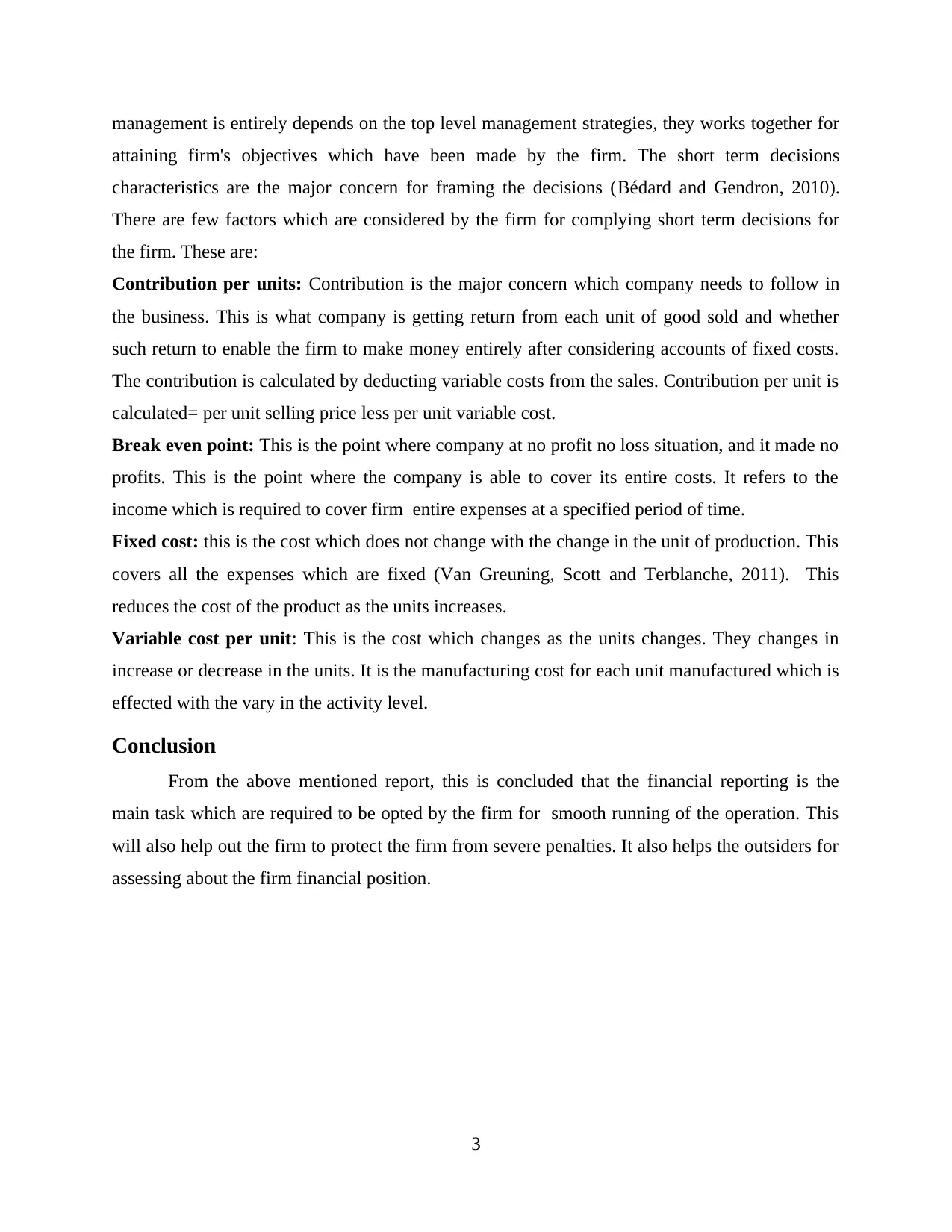
management is entirely depends on the top level management strategies, they works together for
attaining firm's objectives which have been made by the firm. The short term decisions
characteristics are the major concern for framing the decisions (Bédard and Gendron, 2010).
There are few factors which are considered by the firm for complying short term decisions for
the firm. These are:
Contribution per units: Contribution is the major concern which company needs to follow in
the business. This is what company is getting return from each unit of good sold and whether
such return to enable the firm to make money entirely after considering accounts of fixed costs.
The contribution is calculated by deducting variable costs from the sales. Contribution per unit is
calculated= per unit selling price less per unit variable cost.
Break even point: This is the point where company at no profit no loss situation, and it made no
profits. This is the point where the company is able to cover its entire costs. It refers to the
income which is required to cover firm entire expenses at a specified period of time.
Fixed cost: this is the cost which does not change with the change in the unit of production. This
covers all the expenses which are fixed (Van Greuning, Scott and Terblanche, 2011). This
reduces the cost of the product as the units increases.
Variable cost per unit: This is the cost which changes as the units changes. They changes in
increase or decrease in the units. It is the manufacturing cost for each unit manufactured which is
effected with the vary in the activity level.
Conclusion
From the above mentioned report, this is concluded that the financial reporting is the
main task which are required to be opted by the firm for smooth running of the operation. This
will also help out the firm to protect the firm from severe penalties. It also helps the outsiders for
assessing about the firm financial position.
3
attaining firm's objectives which have been made by the firm. The short term decisions
characteristics are the major concern for framing the decisions (Bédard and Gendron, 2010).
There are few factors which are considered by the firm for complying short term decisions for
the firm. These are:
Contribution per units: Contribution is the major concern which company needs to follow in
the business. This is what company is getting return from each unit of good sold and whether
such return to enable the firm to make money entirely after considering accounts of fixed costs.
The contribution is calculated by deducting variable costs from the sales. Contribution per unit is
calculated= per unit selling price less per unit variable cost.
Break even point: This is the point where company at no profit no loss situation, and it made no
profits. This is the point where the company is able to cover its entire costs. It refers to the
income which is required to cover firm entire expenses at a specified period of time.
Fixed cost: this is the cost which does not change with the change in the unit of production. This
covers all the expenses which are fixed (Van Greuning, Scott and Terblanche, 2011). This
reduces the cost of the product as the units increases.
Variable cost per unit: This is the cost which changes as the units changes. They changes in
increase or decrease in the units. It is the manufacturing cost for each unit manufactured which is
effected with the vary in the activity level.
Conclusion
From the above mentioned report, this is concluded that the financial reporting is the
main task which are required to be opted by the firm for smooth running of the operation. This
will also help out the firm to protect the firm from severe penalties. It also helps the outsiders for
assessing about the firm financial position.
3
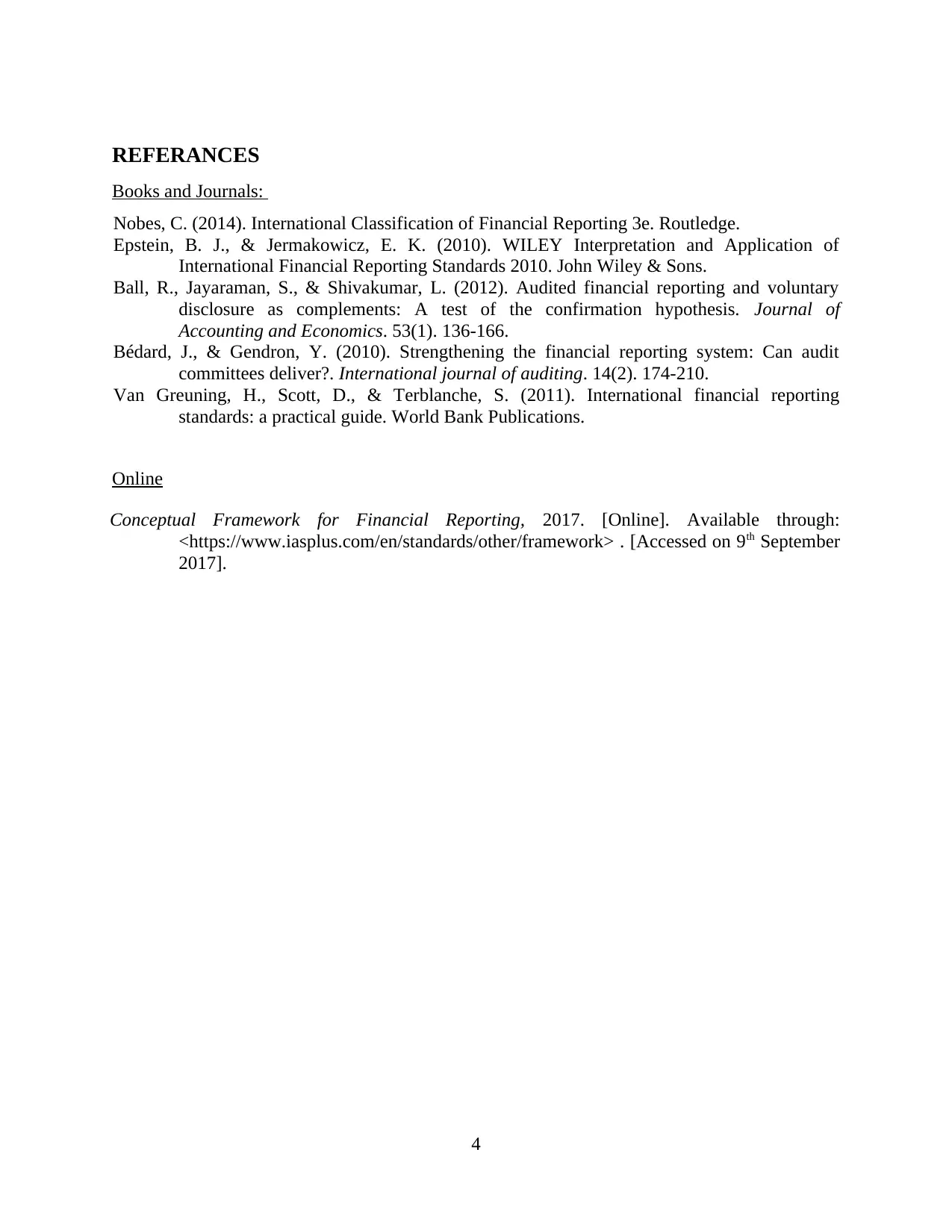
REFERANCES
Books and Journals:
Nobes, C. (2014). International Classification of Financial Reporting 3e. Routledge.
Epstein, B. J., & Jermakowicz, E. K. (2010). WILEY Interpretation and Application of
International Financial Reporting Standards 2010. John Wiley & Sons.
Ball, R., Jayaraman, S., & Shivakumar, L. (2012). Audited financial reporting and voluntary
disclosure as complements: A test of the confirmation hypothesis. Journal of
Accounting and Economics. 53(1). 136-166.
Bédard, J., & Gendron, Y. (2010). Strengthening the financial reporting system: Can audit
committees deliver?. International journal of auditing. 14(2). 174-210.
Van Greuning, H., Scott, D., & Terblanche, S. (2011). International financial reporting
standards: a practical guide. World Bank Publications.
Online
Conceptual Framework for Financial Reporting, 2017. [Online]. Available through:
<https://www.iasplus.com/en/standards/other/framework> . [Accessed on 9th September
2017].
4
Books and Journals:
Nobes, C. (2014). International Classification of Financial Reporting 3e. Routledge.
Epstein, B. J., & Jermakowicz, E. K. (2010). WILEY Interpretation and Application of
International Financial Reporting Standards 2010. John Wiley & Sons.
Ball, R., Jayaraman, S., & Shivakumar, L. (2012). Audited financial reporting and voluntary
disclosure as complements: A test of the confirmation hypothesis. Journal of
Accounting and Economics. 53(1). 136-166.
Bédard, J., & Gendron, Y. (2010). Strengthening the financial reporting system: Can audit
committees deliver?. International journal of auditing. 14(2). 174-210.
Van Greuning, H., Scott, D., & Terblanche, S. (2011). International financial reporting
standards: a practical guide. World Bank Publications.
Online
Conceptual Framework for Financial Reporting, 2017. [Online]. Available through:
<https://www.iasplus.com/en/standards/other/framework> . [Accessed on 9th September
2017].
4
⊘ This is a preview!⊘
Do you want full access?
Subscribe today to unlock all pages.

Trusted by 1+ million students worldwide
1 out of 6
Related Documents
Your All-in-One AI-Powered Toolkit for Academic Success.
+13062052269
info@desklib.com
Available 24*7 on WhatsApp / Email
![[object Object]](/_next/static/media/star-bottom.7253800d.svg)
Unlock your academic potential
Copyright © 2020–2025 A2Z Services. All Rights Reserved. Developed and managed by ZUCOL.





